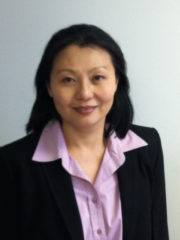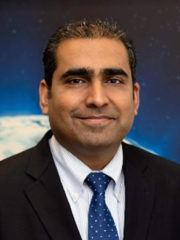April 7, 2022
Plenary V: Multi-Regional TBO Demonstration
Description
The ICAO Global Trajectory Based Operation (TBO) concept describes the exchange of trajectory information across the planning, sharing, and execution phases of trajectory-based operations. Those operations are anticipated to be enabled by technologies such as Connected Aircraft and capabilities such as Flight and Flow Information for a Collaborative Environment (FF-ICE). Panel members will share their perspective on how a Multi-Regional TBO demonstration would be conducted in their FIRs and regions; and discuss related validation activities and the gathering of lessons learned to mature the TBO concept. Panel members will also address potential challenges that will need to be addressed through policy mechanisms and airspace design to deliver TBO.
Chair
Diana Liang, Enterprise Portfolio Manager, FAA
Diana Liang works in the FAA NextGen organization, Ms. Liang has successfully provided direction and oversight on the development and fielding of many of the FAA’s NextGen programs and enabling technologies. In each of her previous roles she has promoted NextGen CNS programs. As acting chief for the NAS Architecture, she helped to manage the FAA’s overall plan for the transition to and implementation of the NextGen systems including the SWIM and Datacom Programs. Ms. Liang, as Enterprise Portfolio Manager, helps to prioritize all NextGen research and development activities with the FAA from a funding and schedule perspective to help the NAS recognize many of the planned performance improvements. This has included strong support for enterprise CNS research. Ms. Liang is the U.S. nominated panel member to the ICAO Information Management Panel (IMP) leading the development of SWIM, information services guidance, and air-ground SWIM.

Panel Members
Nabil Sandhu, FAA, U.S.A
Nabil Sandhu is a project manager in the Federal Aviation Administration’s (FAA) NextGen and Technology Development and Prototyping Division (ANG-C5). He is currently managing the Multi Regional Trajectory-based Operations Demonstration (MR TBO) in addition to other research projects in the areas of unmanned aerial systems (UAS) evaluation and artificial intelligence and machine learning (AI/ML) applications to legacy separation systems. Mr. Sandhu has extensive experience in project management, development and reengineering of business processes including development and coordination of program tactical and strategic initiatives, development and tracking of financial artifacts, and management of programmatic functions.

Amornrat Jirattigalachote, AEROTHAI, Thailand
Dr. Amornrat Jirattigalachote is currently working for AEROTHAI in the position of strategic planning manager (engineering). Since 2013, she has been responsible for strategic planning as well as conducting study and analysis on new technologies and engineering systems for AEROTHAI. Her focus is on modernization planning related to future air navigation concepts such as SWIM (System-Wide Information Management), FF-ICE (Flight and Flow Information for a Collaborative Environment), and TBO (trajectory-based operation). At the global level, she is a member of ICAO Global Air Navigation Plan Study Group (GANP SG) responsible for developing Global Air Navigation Plan, especially Aviation System Block Upgrades (ASBU). At the regional level, she is presently a co-chair of ICAO Asia/Pacific SWIM Task Force. At the sub-regional level, she is part of the team developing ASEAN (Association of Southeast Asian Nations) ANS (Air Navigation Service) Master Plan being implemented under ASEAN Transport Strategic Plan 2016-2025.

Wei Sean Ho, CAAS, Singapore
As the deputy director of ATM Integration and Capability Experimentation at the Civil Aviation Authority of Singapore (CAAS), Wei Wean Ho oversees the technical and operational participation of CAAS in the development of seamless ATM plans, in collaboration with ANSPs and international organizations. His focus is on forging international and regional partnerships to ensure the foundations of mid to long-term interoperable ATM solutions, benefitting network-centric traffic flows and management, are laid out. In addition, he is working on developing innovation gates to verify the potential and value of research and development activities for cross-boundary and cross-regional capabilities. Throughout his career, Wei Sean has undertaken roles in research and development, project management, system engineering, platform, and system integration. Prior to joining CAAS, he was with the defense industry advancing technology development and forming partnerships with the research community. Early in his career, he was focused on the acquisition and upgrading of naval platforms, and integration of complex systems.

Yukio Imada, JCAB, Japan
Yukio Imada is the special assistant to the director Air Navigation Services Planning Division Air Navigation Services Department, Civil Aviation Bureau Ministry of Land, Infrastructure, Transport and Tourism, Japan. He is currently working in the Air Traffic Management Working Group in the framework of Collaborative Actions for Renovation of Air Traffic Systems (CARATS). Mr. Imada has extensive experience in air traffic management. Prior to the special assistant position he worked as an air traffic management officer at the Air Traffic Management Center, CAB, MLIT, Japan. While in that job he worked on air traffic flow management and air space management. Mr. Imada has air traffic controller (ATC) qualifications for enroute airspace and oceanic ATC with data link.

Workshop
Remote ID Rule for Drones: Which Technology Makes the Most Sense?
Description
To accommodate the exponential growth in commercial drone operations, regulatory agencies are moving forward on “remote ID” rules. These rules (e.g., FAA Part 89) will enable drone operations to be fully integrated into U.S. airspace while promoting safety and security. Part 89 requires virtually all types of commercial drones to broadcast remote ID messages via unlicensed radio frequencies that will be compatible with personal wireless devices and subject to the Federal Communications Commission’s (“FCC”) radio-frequency equipment rules. Compliance with the rule requires standards bodies (e.g., ASTM) and manufacturers to make complex tradeoffs between performance, cost, accessibility, security, and safety. This workshop will explore the complex design space and educate decision-makers and engineers on the implementation options for the Remote ID rule.
Chair
Dr. Lance Sherry, Center for Air Transportation Research, George Mason University
Lance Sherry is an associate professor of systems engineering and operations research at George Mason University. Dr. Sherry also serves as the director of the Center for Air Transportation Systems Research at George Mason University. Dr. Sherry has over 30 years of experience in the aviation industry serving as a flight-test engineer, flight control engineer, system engineer, lead system architect, program manager, strategic planning and business development. Dr. Sherry served as a fellow at RAND Corporation 1999-2001. He has published over 100 papers and journal articles, holds several patents, and has received awards for his work.

Panel Members
- Greg Deeds, Technology Exploration Group. Inc, Regulations/Standards
- Mark Nichols, Spanalytics Inc., Remote ID: Bluetooth
- Gregory Tangonan, Ateneo Innovation Center, Remote ID: LoRa-WAN
- Christian Ramsey, uAvionix, Remote ID: ADS-B
- Tim Bagnall, Mosaic-ATM, Detect & Avoid with Remote ID
Awards Ceremony
Presentation of ICNS Best Paper Awards & DASC 2022 Presentation

